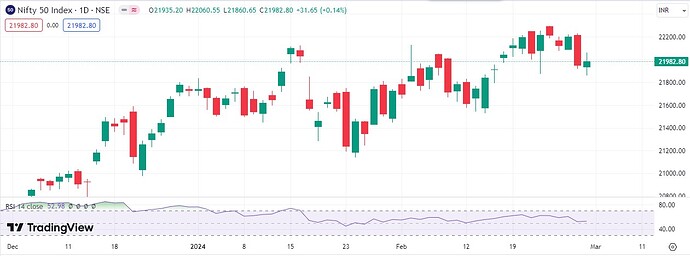Nifty rose 2.95% during the February series expiry. Nifty futures rollover stood at 79.31%, which is lower compared to last month’s expiry rollover of 81.28% and its three months average of 80%. Rollover is a process of carry forwarding an existing position from one month to another month. While a high rollover indicates a strong sentiment, lower- than-average rollovers calls for cautiousness.
Nifty will start the March series with an open interest of 1.40 crore shares compared to an OI of 1.28 crore shares at the beginning of the February series. Nifty saw a lower rollover with a higher cost of carry (+0.90%) and a rise in open interest, compared to its previous month, indicating high chances of profit booking in upcoming series.
INDIAVIX, known as the fear indicator, started with 13.87 and remained flat for the major part of the February series without giving much discomfort to the bulls. It took resistance around the 16.50 levels thrice in this expiry. The volatility cooled off every time the fear gauge came near this level. Any sharp rise in the volatility above this level can give some sleepless nights to the bulls.
The Foreign Portfolio Investors (FPIs) Long Short ratio stood at 24.64% on the first day of February series. The FPIs activity has largely remained subdued despite the Nifty going to hit a fresh all-time high of 22,298 on 23rd February. The current market dynamics show that FPIs continue to maintain a higher proportion of short positions compared to long positions in Index futures. This imbalance, coupled with the recent upward trend in the Nifty, suggests that the momentum of the market rally may be stalling. One contributing factor could be the relatively subdued involvement of FPIs in the current market upswing. The Long-Short ratio ended at 34.99% on the last day of February series expiry.
The Put-Call Ratio (PCR), a sentiment indicator, started with 1.30 on the first day of February series and fell until 0.62 on the last day of February series. The price during the same period, moved up from 21,352 to 21,983. The Price-PCR divergence has emerged as the Put-Call Ratio (PCR) has moved counter to the price trend, indicating a disconnect between market sentiment and price movement. This divergence suggests that the current slowdown in Nifty’s momentum could also be attributed to the lack of active participation by the bulls.
On the Options front in the March monthly expiry, the 21,000 Strike put option has highest open interest with 42,42,750 contracts followed by the 22,000 Strike put option with 35,70,800 contracts. The Strike prices with maximum put open interest are the support levels. While on the call side, the 22,000 call has highest open interest with 24,73,600 contracts followed by the 22,200 Call strike with 20,12,550 contracts. The Strike prices with maximum call open interest are the resistance levels.
Nifty saw a steady up move in the February series expiry. There are four concerning factors in Nifty currently. First being the India VIX, which is showing a strong resistance around the 16.5 levels. A sharp rise in volatility from the current level can drag the Index down. Second being, lack of active participation by the Foreign Portfolio Investors (FPIs) in Index futures. The momentum is unlikely to pick up unless FPIs up the ante in March series. Third is the Price-PCR divergence, which also indicates that the current rally is losing steam. The price and the PCR both move in tandem and divergence between the two usually leads to short term trend reversals. Fourth is the Relative Strength Index (RSI) bearish divergence visible on the daily chart of Nifty. The price has made a higher high while the RSI has made a lower high, leading to a divergence. In all, the derivative and technical indicators justify the slowing down of momentum in Nifty. Both the call & put writers have sizeable positions at the 22,000 Strike in the Index and the option activity at this strike will set the tone for Index’s future direction.
